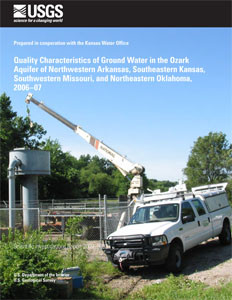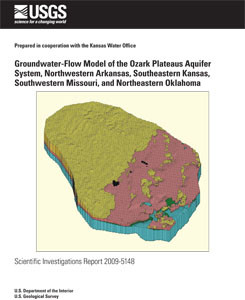
Product Details
- Product Number
- 212345
- Series
- SIR-2009-5093
- Scale
- NO SCALE
- Alternate ID
- SIR2009-5093
- ISBN
- 978-1-4113-2422-0
- Authors
- L M POPE
- Version Date
- 01/01/2009
- Regions
- OK, MO, KS, AR
- Countries
- USA
- Media
- Paper
- Format
- Bound
Additional Details
- Description
- 7/15/2009 Abstract Because of water quantity and quality concerns within the Ozark aquifer, the State of Kansas in 2004 issued a moratorium on most new appropriations from the aquifer until results were made available from a cooperative study between the U.S. Geological Survey and the Kansas Water Office. The purposes of the study were to develop a regional ground-water flow model and a water-quality assessment of the Ozark aquifer in northwestern Arkansas, southeastern Kansas, southwestern Missouri, and northeastern Oklahoma (study area). In 2006 and 2007, water-quality samples were collected from 40 water-supply wells completed in the Ozark aquifer and spatially distributed throughout the study area. Samples were analyzed for physical properties, dissolved solids and major ions, nutrients, trace elements, and selected isotopes. This report presents the results of the water-quality assessment part of the cooperative study. Water-quality characteristics were evaluated relative to U.S. Environmental Protection Agency drinking-water standards. Secondary Drinking-Water Regulations were exceeded for dissolved solids (11 wells), sulfate and chloride (2 wells each), fluoride (3 wells), iron (4 wells), and manganese (2 wells). Maximum Contaminant Levels were exceeded for turbidity (3 wells) and fluoride (1 well). The Maximum Contaminant Level Goal for lead (0 milligrams per liter) was exceeded in water from 12 wells. Analyses of isotopes in water from wells along two 60-mile long ground-water flow paths indicated that water in the Ozark aquifer was at least 60 years old but the upper age limit is uncertain. The source of recharge water for the wells along the flow paths appeared to be of meteoric origin because of isotopic similarity to the established Global Meteoric Water Line and a global precipitation relation. Additionally, analysis of hydrogen-3 (3H) and carbon-14 (14C) indicated that there was possible leakage of younger ground water into the lower part of the Ozark aquifer. This may be caused by cracks or fissures in the confining unit that separates the upper and lower parts of the aquifer, poorly constructed or abandoned wells, or historic mining activities. Analyses of major ions in water from wells along the flow paths indicated a transition from freshwater in the east to saline water in the west. Generally, ground water along flow paths evolved from a calcium magnesium bicarbonate type to a sodium calcium bicarbonate or a sodium calcium chloride bicarbonate type as water moved from recharge areas in Missouri into Kansas. Much of this evolution occurred within the last 20 to 25 miles of the flow paths along a water-quality transition zone near the Kansas-Missouri State line and west. The water quality of the Kansas part of the Ozark aquifer is degraded compared to the Missouri part. Geophysical and well-bore flow information and depth-dependent water-quality samples were collected from a large-capacity (1,900-2,300 gallons per minute) municipal-supply well to evaluate vertical ground-water flow accretion and variability in water-quality characteristics at different levels. Although the 1,050-foot deep supply well had 500 feet of borehole open to the Ozark aquifer, 77 percent of ground-water flow entering the borehole came from two 20-foot thick rock layers above the 1,000-foot level. For the most part, water-quality characteristics changed little from the deepest sample to the well-head sample, and upwelling of saline water from deeper geologic formations below the well was not evident. However, more saline water may be present below the bottom of the well.
- Survey Date
- 2009
- Print Date
- 2009
- Height In Inches
- 11.000
- Width In Inches
- 0.200
- Length In Inches
- 8.500
- Two Sided
- Yes
- Pieces
- 1
- Languages
- English
Related Items




